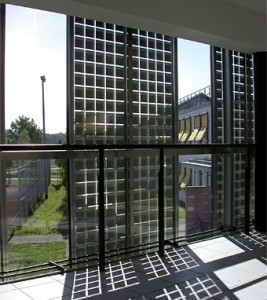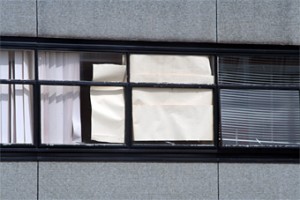
The question of how to qualify and quantify good building performance is not trivial to answer. A well performing building from a carbon footprint perspective may not automatically be well performing in terms of occupant satisfaction (Figure 1).

Fig. 1 – Vertical semi-transparent PV installation in a corridor: good solution in terms of renewables usage. However, solar cells exposed to sunlight act as a radiator to the space behind them. This may cause discomfort.
Similarly building performance may be understood quite differently by different groups of building users as ‘performance’ can be interpreted in many different ways (sketch above). For example, a facilities manager of a large office block can be expected take a different view on good performance of the building than an occasional visitor who is interested in finding his way around the building.
A building with an ‘ideal’ performance would need to be performing well in terms of economics, environment, comfort and design. Of all these aspects comfort is the potentially hardest to address. Therefore it needs to receive a high priority during a building’s design process and ongoing attention during operation. If users do not feel comfortable other performance aspects such as cost effectiveness of the workforce or energy consumption may also detioriate. There are several concepts to examine and predict indoor comfort conditions which try to establish generic rules on the conditions for a good feeling of comfort.

Fig. 2 – Individual solar shading solution ‘installed’ as a reaction to slow response by the building’s facilities management in replacing a broken blind.
However, it is generally agreed that it is not possible to achieve conditions that would be considered comfortable by all building users.
The Sustainable Energy Research Group is trying to gain an understanding of how building occupants effectively use the facilities for environmental control offered to them. Furthermore, user behaviour and the feeling of comfort have been investigated in relation to the environmental room conditions (Figure 2).
